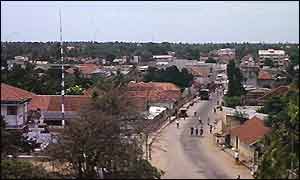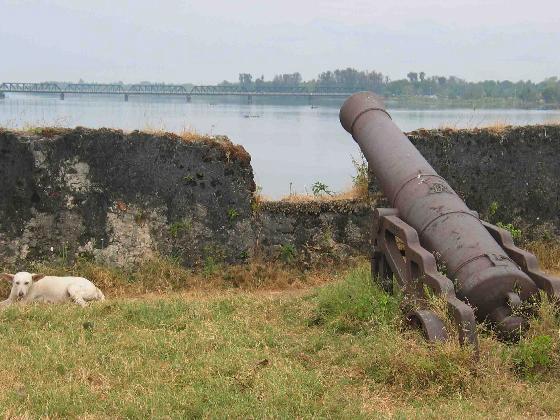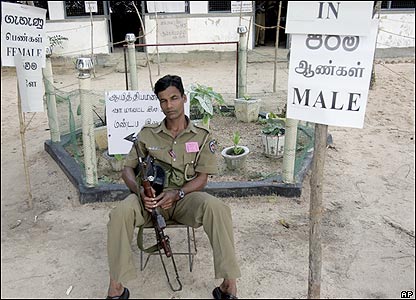
Ilankai Tamil Sangam
Association of Tamils of Sri Lanka in the USA
Published by Sangam.org
by J.S. Tissainayagam, Sunday Times, Colombo, March 2, 2008
|
In the East, while the government might be prepared to pump in billions for reconstruction and development, one vital part of the 'hearts and minds' exercise it has overlooked is that the fundamental reason why the Tamils of the East and North began to wage an armed conflict was because the Sinhala-dominated state was governing Tamil-speaking areas without the consent of the governed. And this fundamental factor has not changed. To believe that the local election in Batticaloa will stem new recruits under these conditions would be to believe that the people did not have hearts, still less minds! |
 |
Batticaloa 2001 |
There is growing consensus today that what drives the forthcoming local government elections in the Batticaloa District is the need for at least a veneer of legitimacy for the government's military pacification in the East. And, if the words of Provincial Councils Minister Janaka Bandara Tennekoon are to be taken seriously, the government aims to hold provincial elections too if the local polls are completed successfully. This will help consolidate legitimacy.
While elections legitimise military pacification, they, as part of a package, are also vital for another reason. The package is a sustained 'hearts and minds' campaign that comes in the wake of a military campaign to defeat rebels holding an area.
The logic for this campaign would be to usher in significant transformation in the environment from what it was under rebel dispensation. This transformed environment would have to have three characteristics: stability, prosperity and democracy. The most demonstrable symbol of democracy is of course elections.
What motivates hearts and minds exercises? The answer is simple and straightforward. You signal to the civilian population that the area, which was once part of a war zone that is now under the authority of the state, has become an enclave or oasis - stable, prosperous and well governed.
 |
| Dutch cannon facing out towards the lagoon bridge, Batticaloa |
If this enclave is to live up to its definition, it cannot be fertile soil for rebels to regroup or have bases - in other words, state forces should have undisputed control. Executed properly, the area as an enclave will be a beacon to the rest of the population under rebel control as to why pursuing a guerrilla war against the state is not cost effective. In other words, if handled well, elections - as part of a pacification package of course - will accomplish one fundamental military milestone - halt the recruitment of new guerrillas to rebel forces because fighting the enemy is not seen as cost effective.
This then is the military dimension of the 'democratization of the East' the government holds up so proudly, which was to come in the wake of the other ingredients of the 'hearts and minds' exercise - Nagenahira Navodaya.
But what is the reality? The East is not an enclave at all. First and foremost, the authority of the government is at the moment tenuous. There are continuing clashes in the so-called newly-cleared areas, which signify the fact that the government cannot prevent infiltration by rebels. In other words, despite their presence, there is an armed challenge to the military in the East.
 |
Voting booth in Batticaloa district during 2005 presidential vote. Picture: BBC |
The second criterion of a successful pacification programme is when the victorious state establishes a set of values that are perceived - and perception is vital here - as a significant break from the past. The public should feel their quality of life is better from what it was.
But what do we have in the East? The TMVP and the army are brutal symbols of the past. Their history of extrajudicial killing, abduction, intimidation and torture continues even today. There is no upturn in the quality of life. That the government has scant regard for instilling new values is best seen from the very act whereby it is seeking legitimacy. The government has such limited political options in the East, that it is contesting local elections in alliance with the paramilitary TMVP.
If violence in the enclave cannot be halted, and governance is carried out by unleashing brutality in doses through groups whose only identity among the public and voters is as paramilitaries, one thing is certain: recruitment to the rebels cannot be staunched.
The enclave theory crumbles further when a suicide bomber killed two TMVP cadres last week in Batticaloa. The very fact that they can infiltrate an area under formal government control means they live amidst the civilian population there. And for a civilian population that is prepared to harbour suicide cadres, sending recruits of their own to swell the ranks of the rebels is but a small step.
A fact that has been stated ad nauseam but still bears repeating is that when the civilian population believes it is facing repression, the recruitment pipeline will not be closed. In the East, while the government might be prepared to pump in billions for reconstruction and development, one vital part of the 'hearts and minds' exercise it has overlooked is that the fundamental reason why the Tamils of the East and North began to wage an armed conflict was because the Sinhala-dominated state was governing Tamil-speaking areas without the consent of the governed. And this fundamental factor has not changed.
To believe that the local election in Batticaloa will stem new recruits under these conditions would be to believe that the people did not have hearts, still less minds!
While elections in newly-pacified areas will not only legitimize military pacification but also act as a deterrent to new recruitment, propaganda too has a role other than that of giving the Sinhala South a feel-good-feeling. This feeling is vitally required because the South forms both the core of the Sri Lankan electorate and augments the ranks of the military.
Whilst government propaganda is supposed to serve as a motivator for recruitment to the military, it is also supposed to serve as a dampener to recruitment of cadres to the enemy. But for that propaganda targeting the population/people should be credible.
The fact that government's figures of LTTE deaths are part of psy-ops has now become accepted though sections of the media question them. Even if we assume newspaper analyses are for the educated, the fact is that informal networks in the villages in the East are robust enough for people not to rely on the media alone to form an opinion of what is going on about the war. Therefore, even if the power of the media to dissuade recruitment might work in the eastern towns, it does not in the villages, which are the core of the LTTE's recruiting ground.
For government-speak to be effective it should place open to doubt the credibility of all other sources of information. But that certainly is not the case here because competing lines of information, many of them accessible to that segment of population which provides most number of recruits, are still active.
Another prop of the government's propaganda war to staunch the flow of recruits to the rebels - playing up Karuna as an eastern Tamil hero - has now lost its glitter with the hero cooling his heels in a British gaol and the TMVP tarnishing its name by openly collaborating with the military.
Therefore, if the government believes that either Batticaloa elections or sustained psy-ops will help accomplish the military objectives they are expected to, it just does not seem to be happening.
© 1996-2025 Ilankai Tamil Sangam, USA, Inc.